
When we deal with Early Modern English, we are talking about the English language that was spoken during the reign of Queen Elizabeth I, that is from the XVth to the XVIth centuries.
For the sake of our analysis, we are to use an EME corpus ((36) ((36))), as well as two plays from Shakespeare, namely Romeo and Juliet, which was written between 1594 and 1597, and Othello, which was written between 1601 and 1608.
In the last chapter, we noticed the morphological impoverishment of the language of Chaucer, that is late ME; still we could still find inflected forms for modals (Sg2 and Pl2 in the present). We also noted the existence of two functional heads: vModal, for deontic modals and Mood, for epistemic modals. In both cases, these modals are raising verbs..
It was also during that period that contracted forms of modals such as WILL, WOULD, SHALL et SHOULD, dummy-DO and the contraction of not appear.
What is then the situation of modal verbs in EME?
Let us first recall the syntax of modal verbs at the ME period. There are two syntactic structures which are closely linked to modality depending on whether the modal is epistemic or deontic. For deontic readings, we have the following structure:
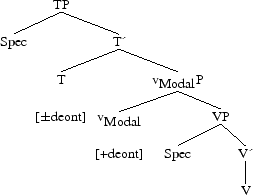
where the modal is base-generated under vModal and fuses with T (at the level of the morphological component), and it is governed by vModal. As for the subject, it is generated under Spec,vP and raises to Spec,TP to satisfy the φ features of T. Moreover, the process of grammaticalisation took place, and we shall see that it is linked to the greater use of the contraction of modals and negation.
For an epistemic modal, the structure is,
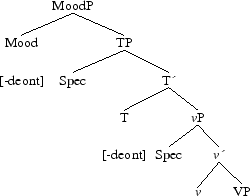
where the modal is generated under T, but it is governed by Mood to satisfy its [-deont] and tense features; as for the subject, it is also generated under Spec,vP, then raises to Spec,TP to satisfy the φ features of T.
If we now have a look at the different instances within the Early Middle English corpus, we can note that EME still has inflected forms for modals, but only for Sg2 (thou).
Farewell, thou canst not teach me to forget. (R&J I,1 231)
Dost thou love me? I know thou wilt say “Ay”,/ And I will take the word; yet if thou swear´st,/ Thou mayst prove false: at lovers perjuries,/ They say Jove laughs. (R&J II,11 32-5)
Thou desirest me to stop in my tale against the hair./ Thou wouldst else have made thy tale large. (R&J II,3 86-7)
I do protest I never injuri´d thee,/ But love thee better than thou canst devise,/ Till thou shalt know the reason of my love; (R&J III,1 66-8)
That thou, Iago, who hast my purse,/ As if the strings were thine,shouldst know of this. (Oth I,1 2-3)
O heavy ignorance, thou praisest the worst best! But what praise couldst thou bestow on a deserving woman indeed? (Oth II,1 142-3)
It is the same when we are dealing with the lexical forms of modals (note: ➳),
Shall ever medicine thee to that sweet sleep/ Which thou owedst yesterday. (Oth III,3 336-7)
Therefore stay yet, thou need´st not to be gone. (R&J III,5 16)
And, if thou dar´st, I´ll give thee remedy. (R&J IV,1 76)
Later on in our work, we shall see that the syntactic position of modal verbs will be different from the one for modals used lexically, as has been underlined so far.
In Shakespeare, CP-V2 structures can be found, but mainly with the lexical forms of modals, as in Example (465),
What, dares the slave/ Come hither, cover´d with an antique face,/ To fleer and scorn at our solemnity? (R&J I,4 165-7)
What, are you busy, ho? Need you my help? (R&J IV,3 6)
Wert thou as young as I, Juliet thy love,/ An hour but married, Tybalt murdered,/ Doting like me, and like me banished,/ Then mightst thou speak,/ Then mightst thou tear thy hair;/ And fall upon the ground as I do now,/ Taking the measure of an unmade grave. (R&J III,3 65-70)
My husband?/ What needs this iteration? Woman, I say thy husband. (Oth V,2 152-3)
We also find instances where modals are used lexically,
I would not for the world they saw thee there. (R&J II,1 116)
Nay, he will answer the letter´s master, how he dares, being dared. (R&J II,3 11-2)
I have more care to stay than will to go./ Come, death, and welcome, Juliet wills it so. (R&J III,5 23-4)
Come hither, gentle mistress:/ Do you perceive in all this noble company,/ Where most you owe obedience? (Oth I,3 165-7)
Be it as you shall privately determine,/ Either for stay or going, the affairs cry haste,/ And speed must answer, you must hence tonight. (Oth I,3 260-3)
I durst, my lord, to wager she is honest, /Lay down my soul at stake : if you think other,/ Remove your thought, it doth abuse your bosom. (Oth IV,2 12-4)
My lord, I would I might entreat your honour/ To scan this thing no farther, leave it to time; (Oth III,3 248-9)
Yet, unlike OE, we find new forms in EME, partucularly contracted forms of modal verbs, which reflect their grammaticalisation: they now are functional heads to be considered as clitics within DM when they are contrated; they can merge with the subject which is to “bear” them.
Go waken Juliet, go and trim her up,/ I´ll go and chat with Paris. (R&J IV,4 24-5)
And then to have a wretched puling fool,/ A whinning mammet, in her fortune´s tender,/ To answer, “I´ll not wed, I cannot love,/ I am too young, I pray you pardon me!” (R&J III,5 185-8)
This cannot anger him; ´twould anger him/ To raise a spirit in his mistress´ circle/ Of some strange nature, letting it there stand/ Till she had laid it and conjur´d it down; (R&J II,1 23-6)
No, ´tis not so deep as a well, nor so wide as a church door, but ´tis enough, ´twill serve: ask for me tomorrow, and you shall find me a grave man. (R&J III,1 93-5)
But still the house affairs would draw her thence,/ And ever as she could with haste dispatch,/ She´ld come again, and with a greedy ear/ Devour up my discourse; (Oth I,3 134-7)
He told me, he´d have nothing to do with it, (LISLE-E3-P1,4,109.205)
Were I but sure of that, I´d quickly lay my Case before you. (VANBR-E3-P1,51.406)
These examples are interesting for three reasons: 1) because there is contaction of the modal, grammaticalisation is visible; if there is contraction, it implies that the modal is a functional head which can morphologically merge with the adjoined nominal head of the subject; 2) only WILL has the contracted form we find in CE, but for WOULD, we can find different types of contractions; and 3) in some examples, the contraction of the modal is not a bound morpheme but the subject pronoun.
By the end of the ME period, we remarked only two forms for modal verbs remained. In the following table, we summerize ME and EME modals.
| EME | ||
| ME | PRESENT | PAST |
| WITEN | - | - |
| OWE * | - | - |
| DUGEN | - | - |
| UNNEN | - | - |
| CUNNEN | CAN | COULD |
| ÐURFEN * | - | - |
| DURREN | DARE | - |
| MON | - | - |
| SCULEN | SHALL | SHOULD |
| MOTEN | MUST | - |
| MAGEN | MAY | MIGHT |
| WILLEN | WILL | WOULD |
| [NIEDAN-NEADIAN *] | NEED | - |
This table allows us to note the following points:
1. The class of the preterite presents is now limited, and we are now dealing with the class of modal verbs. Some of the members have disappeared (WITEN, DUGEN, UNNEN, MON and ÐURFEN), but one is also a lexical verb (WITEN).
Full well I wot the ground of all this grudge. (Titus Andronicus II,1 48)
Ah, Marcus, Marcus, brother, well I wot/ Thy napkin cannot drink a tear of mine, (Titus Andronicus III,1 139-40)
As for ÐURFEN, it has been replaced by NEED.
2. In EME, DURREN has only one present form, but whenever it is past, it is a lexical verb.
I durst, my lord, to wager, she is honest, (Oth IV,2 12)
It will be the same for OWE: we can find instances where it is used both lexically and modally.
Do you perceive in all this noble company,/ Where most you owe obedience? (Oth I,3 166-7)
Look where he comes: not poppy, not mandragore,/ Nor all the drowsy syrups of the world/ Shall ever medicine thee to that sweet sleep/ Which thou owedst yesterday. (Oth III,3 334-7)
and greatest authoritie to amend it, as good and wise magistrates ought to do (ASCH-E1-P1,8R.114)
yee also ought to wash one anothers feete. (AUTHNEW-E2-P1,XIII,1J. 181)
you ought to pay some respect to this stranger... (BEHN-E3-H,189.155)
3. MOTEN only has one form in EME: it is morphologically a past form, but grammatically, it is present in meaning. For most of the examples, MOTEN could have been replaced by OUGHT TO.
moste nedes be doone, with thy charte... (FITZH-E1-P2,29.78)
Simon, thou moste suffer as well as I myselfe; (FORMAN-E2-H,10.220)
The father of heauen mote strenght thy frailtie, my good daughter and the frayltie of thy fraile father too (MORELET2-E1-H,545.81)
4. We have only found one example of MON,
none of your servants shall not pas the dowers, but they mon be trobled... (APLUMPT-E1-H,186.103)
5. Finally, we can notice the absence of infinitive forms in EME, as well as the standardization of the past forms of CAN, SHALL and WILL.
Comapred to OE and ME, the meaning of modal verbs in EME has changed. This change seems to go along with the grammatical change they have undergone.
MAY had a meaning very close to CAN. In EME, it is to keep the meaning of permission and possibility, but CAN is now to have the meaning of physical ability, whereas in OE and ME, it refered to knowledge and capacity.
In OE, MUST had the meaning of “be allowed, have the capacity” as well as “must”. By the end of ME, it had the meaning of “must, ought”, which is the same in EME.
In OE and ME, OUGHT had the meaning of “have, possess, own”. In EME, OUGHT is (semi-)modal, and we have the lexical verbs owe, own.
MON is no longer used in EME; neither is WITEN, which is only to be found as a lexical verb (or under nominal and adjectival forms).
As for NEED, DARE and WILL, they are the only verbs to be both lexical and modal; concerning NEED, its morphological form is taken from NIEDAN, NEADIAN, the form ÐURFEN has disappeared.
At the beginning of this chapter, we recalled the ME structures of modals. With examples, let us see what their structures are in EME (showing no differences between epistemic and deontic modals yet).
The following examples display contracted forms.
they´d think surely we kept a bawdy house... (PENNY-E3-H,117.66)
you´d be laught at soundly, (MIDDLET-E2-P1,36.453)
I´ll give thee twenty for it. (ARMIN-E2-H,46.423)
we´ll drink his Health. (FARQUHAR-E3-H,3.99)
These are all instances of WILL. Now, all modals are generated under T, because they merge with the subject. Thus, they have become functional heads (there is Fusion [N-T], according to Distributed Morphology).
´twill be with less relucktancy then ever I did in my life. (ANHATT-ON-E3-H,2,212.14)
´twill be more like Oroonoko to encounter him at an army´s head... (BEHN-E3-P2,176.96)
´Twou´d be hard to guess which of these Parties is the better pleas´d, (FARQUHAR-E3-P1,72.800)
´twill doe the childe noe harme... (LOCKE-E3-P1,42.175)
´Twould be a Iest through the whole Vniuersitie, (MIDDLET-E2-P1,36.455)
´twould have sav´d you many a Tear. (VANBR-E3-P1,45.205)
Nevertheless this second type of contraction is not specific to WILL et WOULD, but also to the auxiliary BE: the subject pronoun it merges with these verbal forms; or, in some contexts, that is when it is an object, it becomes the free morpheme ´t. Those contractions tell us modals are indeed grammatical items generated under T.
Thus, Examples (496) (Structure (503)) and (500) (Structure (504)) have the following structures,
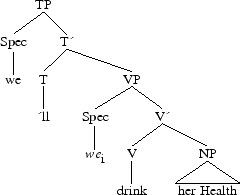
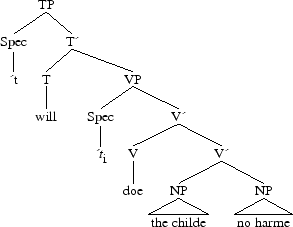
We shall not analyze this point any further, it will be dealt with in forthcoming research.
It is noteworthy that the use of dummy-DO has not been generalized yet: we still find negative imperatives and questions without DO, or finite verbs followed by the negation not; but the EME language is already using the emphatic DO, as well as DO bearing tense and the contraction of the negation.
Doth she not think me an old murderer, (R&J III,3 93)
what doeth hinder me to be baptized? (AUTHNEW-E2-P2,VIII,20A.308)
What doth it import then... ? (BOETHPR-E3-P1,55.330)
And yet no man like he, doth grieve my heart. (R&J III,5 84)
Thou told´st me,/ Thou didst hold him in thy hate. (Oth I,1 7)
because they can refuse a Man they don´t like, when they have got one they do. (VANBR-E3-P1,55.544)
You shall not write my praise./ No, let me not (Oth II,1 116)
I speak not yet of proof:/ Look to your wife, observe her well with Cassio; (Oth III,3 200-1)
In examples displaying DO, the syntactic position for this constituent is the same as modals: it is base-generated under T as it bears tense and the bound morpheme for negation. The use of dummy-DO implies the verb does not raise to T anymore (in terms of DM, we have shifted from Fusion to Merge). In affirmative sentences, Affix Hopping then applies.
not any in the court durst but haue sought him, which this man did, (ARMIN-E2-H,43.282)
At last out comes William with his wit, as the foole of the play does, ... (ARMIN-E2-H,45.367)
and yet they carry many tymes, as good and costlie ware, as greater vessels do. (ASCH-E1-H,20R.120)
Wilt thou kill me, as thou diddest the Egyptian yesterday? (AUTHNEW-E2-P2,VII,20A.124)
This last example has the following structure,
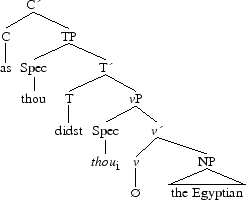
We can find identical structures for modals, which indicate they have the same syntactic position and they are grammtical items.
And what should I doe? (ARMIN-E2-H,44.345)
Canst thou change mee a crowne? (ARMIN-E2-P1,19.143)
and wilt thou reare it vp in three dayes? (AUTHNEW-E2-H,II,20J.219)
and to give him all the satisfaction I possibly could: (BEHN-E3-H,192.205)
they desyre naturally to lyue as longe as they may. (BOETHCO-E1-H,81.514)
The structure of Examples (507) and (518) is identical, with a movement from T to C.
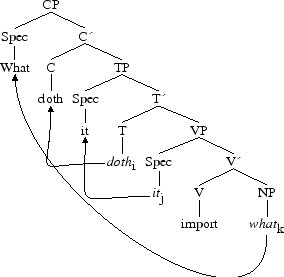
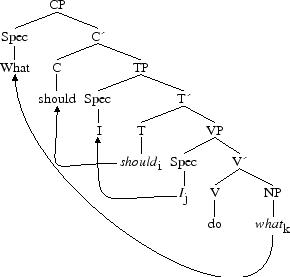
We have just demonstrated that modals and dummy-DO have the same syntactic structure.
The examples to come are instances of a CP-V2 structure still in use in EME. Yet, we shall find these structures only with lexical verbs such as WILL, NEED and DARE, which proves that, at that period, lexical verbs can still be strong and raise from V to T, and then to C. The absence of modal verbs for this kind of structure (*Can he the book?) shows they are grammatical items which are not the event or the action, but are part of it (i.e. as operators, they are part of the evaluation of the clause in terms of truth).
My husband?/ What needs this iteration? Woman, I say thy husband. (Oth V,2 152-3)
What said she to you? (Oth I,1 148)
The last example will have the following structure,
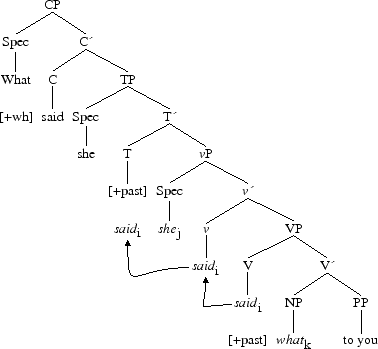
In EME, as lexical verbs tend to still be strong (but not in every case), movement from V to T to C can take place.
Seeing the preceding examples, we can thus claim a syntactic competition between V2 and SVO structures still exists, but it is no longer true for modal verbs.
How can we consider inflected forms that can still be found in EME?
Except for present and past, lexical and modal verbs can be marked Sg2. These forms are morphologically identical to the ones found in OE and ME, excepting one point: there is no longer vowel alternation. The status of the root of modals is not considered as a verb anymore but as one of the morphemes constituting a paradigm (note: ➳). Then,
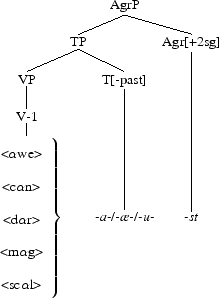
becomes for the present and past in EME,
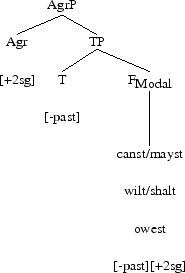
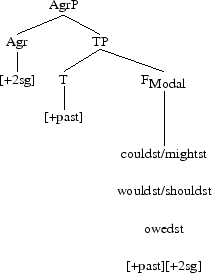
This does not change the syntactic position of modals.
In EME, the main negation becomes not and it immediately follows the modal.
I hate the Moor,/ And ´tis thought abroad that ´twixt my sheets/ H´as done my office; I know not if´t be true... (Oth I,3 365-7)
Saints do not move, though grant for prayer´s sake./ Then move not my prayer´s effect I take,/ Thus from my lips, by thine my sin is purg´d. (R&J I,4 215-7)
Doth she not think me an old murderer, (R&J III,3 93)
As we have mentioned, we did not find examples of the contraction of the negation, or its merge with modal or dummy-DO in ME. In EME, the situation is very different since the negation ´nt can be found for every modal, but only one example for DO (Example (510)).
because they can refuse a Man they don´t like, when they have got one they do. (VANBR-E3-P1,55.544)
a good one can´t cost les then 60 pound. (ALHATTON-E3-H,2,241.19)
Men won´t own it for their Opinion... (FARQUHAR-E3-H,4.164)
I shan´t be home till it be late. (FARQUHAR-E3-P2,35.650)
she mayn´t see who is her Husband´s Mistress. (VANBR-E3-P1,54.519)
Considering these examples, we note that the position of the negation in EMEM is the same as ME.
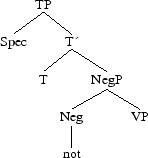
Let us now have a look at some examples. We shall analyze three of them: one displaying MD + NOT (Example (539)), another displying the fusion of NOT with CAN (Example (540)) and a last one which is a question (Example (545)).
I would not follow him then. (Oth I,1 40)
We cannot be all masters, nor all masters/ Cannot be truly follow´d. (Oth I,1 43-4)
It is as sure as you are Roderigo,/ Were I the Moor, I would not be Iago. (Oth I,1 56-7)
Zounds, sir, you are one of those that will not serve God, if the devil bid you. (Oth I,1 108-9)
He that is strucken blind cannot forget/ The precious treasure of his eyesight lost. (R&J I,2 226-7)
I dare not say he lies any where. (Oth III,4 2)
To be call´d whore? Would it not make one weep? (Oth IV,2 124)
The slip sir, the slip, can you not conceive? (R&J II,3 58)
I would not follow him then. (Oth I,1 40)
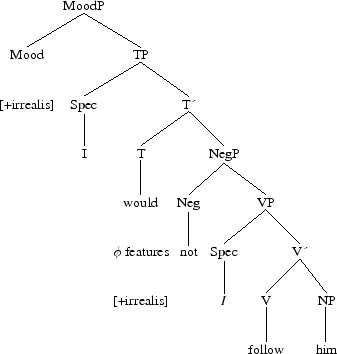
The one for (540), now numbered (548.a), is
We cannot be all masters, nor all masters/ Cannot be truly follow´d. (Oth I,1 43-4)
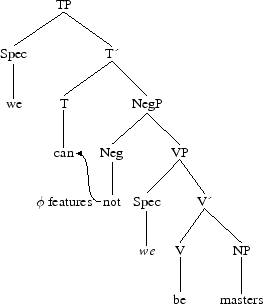
The structure of (545), now numbered (549.a), is
To be call´d whore? Would it not make one weep? (Oth IV,2 124)
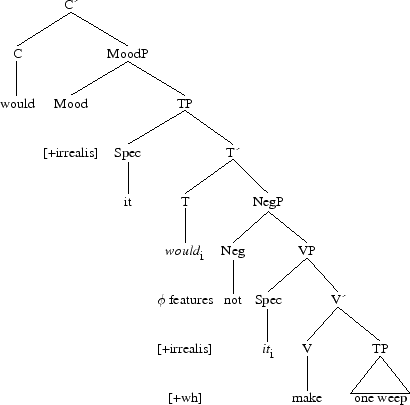
But we also find examples where not does not immediately follow the modal, and the sentence negation is different.
Peace, you mumbling fool,/ Utter your gravity o´er a gossip´s bowl,/ For we need it not. (R&J III,5 174-6)
I neither know it, nor can I learn of him. (R&J I,1 138)
Yet I persuade myself, to speak the truth,/ Shall nothing wrong him. (Oth II,2 211-2)
Come go good Juliet, I dare no longer stay. (R&J V,3 159)
In late ME, we had found very few examples of negative polarity items, which implied negative concord still applied before that period. Let us now take some examples in EME.
Thou wast never with me for anything when thou wast not there for the goose. (R&J II,3 70-1)
marry, I would not do such a thing for a joint ring; or for measures of lawn, nor for gowns, or petticoats, nor caps, nor any such exhibition; (Oth IV,3 43-5)
I will not againe curse the ground any more for mans sake. (AUTHOLD-E2-H,VIII,20G.464)
there hath not beene since Christs time any King or temporall Monarch which hath ben so learned... (BACON-E2-P1,1,2V.16)
and will not shew you any pleasure... (THOWARD2-E2-P1,1,94.423)
but he had not made any Conclusion in that Matter with her, (THOWARD2-E2-P1,1,97.556))
I do not remember any such Prophecy. (THOWARD2-E2-P2,1,100.29)
These examples prove that negative concord tends to disappear in EME: two negative words in one sentence do not express one single negation, but they cancel each other out; hence the appearance of negative polarity items like any and its compounds. As for Neg criterion, it still applies with negative polarity items.
As far as modal verbs are concerned, the analysis is identical as the one carried in the last chapters: when they are followed by a non finite verb, this verb belongs to a VP, unlike lexical verbs which take either a CP or a TP as a complement. As for causative verbs, they now have the same structure as modals: they take a VP complement and become operator verbs now generated under v, and no more under V. They thus has grammaticalised: from to lexical to semi-lexical verbs.
In the last chapter, we underlined the fact that the disappearance of the inflected forms of infinitives and subjunctives ended in the grammaticalisation of modals as well as the absence of adequacy between morphological form and past value of some modals such as SHOULD, WOULD, COULD and MIGHT.
In EME, this differentiation between morphology and tense becomes more pronounced. Indeed, more often than not, SHOULD, WOULD, COULD and MIGHT have an irrealis meaning. The past tense is more frequently expressed with the perfective aspect, that is, using HAVE + V + EN.
As in the last chapter, we have found more and more examples of the structure MD + HAVE + EN.
In all these examples, the perfective aspect expresses the past tense of the utterance, and the modal form is to express the [-irrealis] mood when it is a present form and the [+irrealis] mood when it is a past form (sometimes, according to the context, a past form could have a past meaning).
seeing them, she would have run in again. (BEHN-E3-H,189.153)
the most illustrious courts could not have produced a braver man, (BEHN-E3-P1,153.91)
euin them that for loue of Justice among the Courtiers might haue saued me, (BOETHEL-E2-P1,9.34)
I could easily enough have detected the Falseness of that Contrivance, even by the Confessions of my Accusers, which is of greatest Weight in all such Affairs if I might have been allowed to have made use of them. (BOETHPR-E3-P1,23.67)
It is sayde that I wuld haue saued the senators. (BOETHCO-E1-P1,20.47)
This last example has the structure which was given in the last chapter, but we are only underlining the mood of the modal, not its reading.
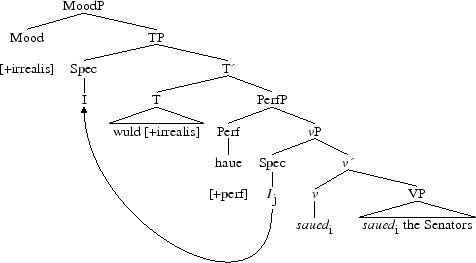
In structures like MD + HAVE + EN, the [+perf] feature will have the value of a [+past] feature.
Despite what has just been said, the past forms of CAN, SHALL, MAY and WILL can still have a past meaning, with a T [+past].
And since that time it is eleven years,/ For then she could stand high-lone. Nay, by th´rood,/ She could have run and waddled all about: (R&J I,3 37-9)
O, she knew well/ Thy love did read by rote, that could not spell. (R&J II,2 87-8)
(...) the searchers of the town, (...) Seal´d up the doors, and would not let us forth,/ So that my speed to Mantua there was stay´d./ Who bare my letter then to Romeo?/ I could not send it, here it is again, (R&J V,3 8-14)
I think/ He told me Paris should have married Juliet./ Said he not so? (R&J V,3 77-9)
The Anthropophagi, and men whose heads/ Do grow beneath their shoulders: this to hear/ Would Desdemona seriously incline;/ But still the house affairs would draw her thence,/ And ever as she could with haste dispatch,/ She´ld come again, and with a greedy ear/ Devour up my discourse; (Oth I,3 131-7)
Yet surely Cassio, I believe, receiv´d,/ From him that fled, some strange indignity,/ Which patience could not pass. (Oth II,3 233-4)
As we have just mentioned, past forms can have a past meaning, where tense and time merge. But, past forms of modals are more and more often used to express the irrealis mood, and more particularly the conditional. The functional head for it is Mood [+irrealis]. In irrealis sentences, the modal is base-generated under T and it has the morphological feature [+past]. However, as it is governed by the head Mood (it is then out of the scope of T, in the CP domain), it possesses an [+irrealis] feature. As for the tense, it is “born” by the infinitive: if it is a present infinitive, as in I would come, the modal is a present conditional; if it is a past infinitive, as in I would have come, the modal is a past conditional.
Then, when we have the structure WOULD/SHOULD/COULD/MIGHT + V, the tense of the sentence is a present conditional, as in the following examples,
O heavy ignorance, thou praisest the worst best! But what praise couldst thou bestow on a deserving woman indeed? (Oth II,1 142-3)
Wouldst thou do such a deed for all the world?/ Why, would you not?/ No, by this heavenly light./ Nor I neither, by this heavenly light,/ I might do it as well in the dark. (Oth IV,3 34-40)
Not tonight, good Iago; I have very poor and unhappy brains for drinking: I could well wish courtesy would invent some other custom of entertainment. (Oth II,3 30-2)
And when the structure WOULD/SHOULD/MIGHT + HAVE + V + EN is displayed, the tense is a past conditional,
Indeed I should have ask´d you that before. (R&J I,2 76)
That villain cousin would have kill´d my husband. (R&J III,2 101)
Thou desirest me to stop in my tale against the hair./ Thou wouldst else have made thy tale large. (R&J II,3 86-7)
Were it my cue to fight, I should have known it/ Without a prompter. (Oth I,2 76-7)
He might ha´ chid me so, for, in good faith,/ I am a child at chiding. (Oth IV,2 110-1)
These examples underline the fact that the perfective aspect marks the past tense.
In the following examples, all modals belong to the irrealis sphere and they are followed by a modal past when there is a finite verb (italicized).
I would not for the world they saw thee here. (R&J II,1 116)
And yet I would it were to give again./ Wouldst thou withdraw it? (R&J II,1 167-72)
I would I were thy bird./ Sweet, so would I,/ Yet I should kill thee with much cherishing. (R&J II,1 223-4)
My lord, I would that Tuesday were tomorrow. (R&J III,4 29)
What wouldst thou write of me, if thou shouldst praise me? (Oth II,1 117)
My lord, I would I might entreat your honour/ To scan this thing no farther, leave it to time; (Oth III,3 248-9)
It is as sure as you are Roderigo,/ Were I the Moor, I would not be Iago. (Oth I,1 56-7)
We can also find examples of lexical verbs expressing a present subjunctive and whose form looks like a present simple one; then, only the context will help us know they are irrealis forms introduced by if.
He´ll watch the horloge a double set,/ If drink rock not his cradle. (Oth II,3 119-20)
If love be blind love cannot hit the mark. (R&J II,1 33)
All these different examples have allowed us to show that morphological past forms of modals (as well as some present and past forms) could have an irrealis value.
In the last two chapters, we established a hierarchy for the adverbs and the functional heads they were related to (we refer the reader to Section 2.7 for OE and to Section 3.8 for ME). Let us recapitulate.
[sweotole/sweotollice clearly, precisely, fullice perfectly, fully, gewislicost certainly, surely, gerisenlice honorably, conveniently, huru yet, certainly, openlicor obviously, hluttorlice sincerely, clearly, rihtlice right, well, smealice precisely, subtly MoodEvidential [eft again, nu now, iu precedingly, eac since T(Past) [þa/þonne then, nu now, teowardlice towards T(Future) [nede necessarily, aninga willingly ModNecessity [eað willingly, lustlice willingly ModVolitional [swa thus, consequently ModObligation [hioweslice? informally AspHabitual [eft again, gelomlice frequently AspRepetitive(I) [eft again, gelomlice frequently AspFrequentative(I) [aninga rapidly AspCelerative(I) [emb before, after, iu precedingly, syððan since, now, then, eac? since T(Anterior) [get yet, again, gen already, now, again, swa thus, consequently AspContinuative [a/(n)æfre never, always, simble always, constantly AspPerfect[ær before, once AspRetros- pective [sona soon, sel/selust soon, hrædlicor suddenly AspProximative [leng long AspDurative [neah near, almost AspProspective [fullice perfectly, completely AspSg.Completive(I) [wel well, sel/selust soon, geara formerly, once Voice [aninga rapidly, geara formerly, once AspCelerative(II) [fullice perfectly, completely AspSg.Completive(II) [eft again, gelomlice frequently AspRepetitive(II) [eft again, gelomlice frequently AspFrequentati- ve(II)]]...
In ME, we added the functional head ModPossibility which went along the functional head ModNecessity.
What is now the situation in EME? If grammaticalisation has indeed taken place, it would imply that the use of modality adverbs is greater at that period.
The following examples give an illustration of the different positions where adverbs can be found. As in OE and ME, the functional heads are identical; but unlike OE an ME, examples (610) and (611) are interesting ones. We can then find the following structures,
MD + ADV + V,
Valliant Othello, we must straight employ you/ Against the general enemy Ottoman; (Oth I,3 39-40)
Be it as you shall privately determine,/ Either for stay or going, ... (Oth I,3 260-1)
I will incontinently drown myself./ Well, if thou dost, I shall never love thee after it. (Oth I,3 289-90)
which the time shall more favourably minister. (Oth II,1 258)
That you shall surely find him:/ Lead to the Sagittar the raised search,/ And there will I be with him. (Oth I,1 139-41)
I will rather sue to be despis´d than to deceive so good a commander with so light, so drunken, and indiscreet an officer. (Oth II,3 265-7)
as the time, the place, the condition of this country stands, I could heartily wish this had not so befallen; (Oth II,3 284-6)
For thy sollicitoe shall rather die/ Than give thy cause away. (Oth III,3 27-8)
and you might quickly make it right. (Oth IV,3 51-3)
Could we but learn from whence his sorrows grow,/ We would as willingly give cure as know. (R&J I,1 148-9)
But I am sent to find those persons whose names are here writ, and can never find what names the writing person hath here writ. (R&J I,2 41-4)
I fear too early, for my mind misgives/ Some consequence, yet hanging in the stars,/ Shall bitterly begin his fearful date... (R&J I,4 104-7)
Ah, my mistresses, which of you all/ Will now deny to dance? (R&J I,4 128-9)
MD + ADV + HAVE + P.PASSE / MD + BE + ADV + P.PASSE,
We cannot be all masters, nor all masters/ Cannot be truly follow´d. (Oth I,1 43-4)
The wealthy curled darlings of our nation,/ Would ever have (to incur a general mock)/ Run from her guardage to the sooty bosom/ Of such a thing as thou? (Oth I,2 67-70)
Blest fig´s end! The wine she drinks is made of grapes: if she had been blest, she would never have lov´d the Moor. (Oth II,1 243-4)
I saw no man use you at his pleasure: if I had, my weapon should quickly have been out. (R&J II,3 141-2)
MD + V + ADV,
My parts, my title, and my perfect soul,/ Shall manifest me rightly: is it they? (Oth I,2 31-2)
I am not drunk now, I can stand well enough, and speak well enough. (Oth II,3 105-6)
and ADV + MD + V / HAVE + EN,
By heaven, I rather would have been his hangman. (Oth I,1 34)
And Cassio high in oaths, which till tonight/ I ne´er might see before; (Oth II,3 222-4)
When we have a simple verbal structure, that is a modal plus an infinitive, the adverb has the same position as in CE: between the modal and the infinitive, but also after the infinitive. In the complex verbal structures MD + BE / HAVE + V + EN, we have the same position CE has; nevertheless, for these structures, we have not found examples where the adverb was between BE/HAVE and V + EN. Finally, in all these examples, adverbs are either generated within the TP domain, or the vP domain, under specific functional heads.
We said that, as early as the late OE period (950-1050), we could find some epistemic modals. In ME, we could find some more, and in EME, this number rises.
Let us then give examples of both epistemic and deontic modals, having in mind they do belong to raising structures.
Let us first recall what epistemic and deontic modality is.
Epistemic modality can be defined as follows: it indicates the level of implication of the speaker in what he/she is saying. Etymologically, epistemic means “understanding” or “knowledge”; an epistemic modal then expresses the understanding or the knowledge of the speaker in relation to the terms of his/her utterance, and the assessment of the predicative relation is done in the tense of the utterance.
Deontic modality is to be defined as follows: unlike epistemic modality, a deontic modal implies a notion of action, an idea of will from a third person or from the speaker; in both cases, tense has a semantic scope on the modal.
To sum up, we could say that epistemic modality modifies the sentence and deals with the truth value of that sentence; as for deontic modality, it relates a subject and an activity, and deals with the notions of permission, obligation and will.
In the following examples, the modals between square brackets are epistemic,
Sir, he´s rash, and very sudden in choler, and haply with his trucheon [may] strike at you: provoke him that he [may], for even out of that will I cause these of Chyprus to mutiny, whose qualification shall come into no true trust again, but by the displanting of Cassio. (Oth II,1 260-4)
For Michael Cassio,/ I [dare] presume, I think that he is honest./ I think so too. Men should be what they seem,/ Of those that be not, would they [might] seem none./ Certain, men should be what they seem. (Oth III,3 127-31)
In these examples, modals are deontic,
Heaven is here/ Where Juliet lives, and every cat and dog/ And little mouse, every unworthy thing,/ Live here in heaven and [may] look on her,/ But Romeo [may] not. (R&J III,3 29-33)
It is a judgement maim´d, and most imperfect,/ That will confess perfection so [would] err/ Against all rules of nature, and [must] be driven/ To find out practices of cunning hell/ Why this [should] be: (Oth I,3 89-93)
you [must] awhile be patient:/ What I can do I [will], and more I [will]/ Than for myself dare, let that suffice you. (Oth 122-4)
An ´a speak anything against me, I´[ll] take him down an ´a were lustier than he is, and twenty such jacks; and if he cannot, I´[ll] find those that [shall]. Scurvy knave! I am none of his flirt-gills, I am none of his skain-mates. And thou [must] stand by, too, and suffer every knave to use me at his pleasure... (R&J II,3 135-40)
Happily met, my lady and my wife./ That may be, sir, when I may be a wife./ That “may be” [must] be, love, on Thursday next./ What [must] be [shall] be. That´s a certain text. (R&J IV,1 18-21)
In some of these examples, we can find, in a single sentence, both epistemic and deontic modals (Examples (616), (617) and (618))
As we had found examples of epistemic modals in OE, it implied that the process of grammaticalisation could be seen. As a consequence, we introduced the functional head Mood which has both the [+irrealis] and [-deont] features. For deontic modals, we showed they had the specific syntactic position vModal.
That was also to be found in ME, the only difference being modals are directely base-generated under T.
In EME, we still have these two positions, but we shall analyze further what the implication of modals being generated under T is.
At that stage of our analysis, the structure of the EME sentence is:
CP - MoodP - TP - NegP - vModalP - (vP) - VP.
In the last two chapters, we underlined that both epistemic and deontic modals were raising verbs. Let us take two examples, with the same modal which has two different readings:
He must be mad (epistemic)
[TP Hei [T must [VP [Spec ti be mad]]]]
He must be careful (deontic)
[TP Hei [T must [VP [Spec ti be careful]]]]
These examples have the following structures,
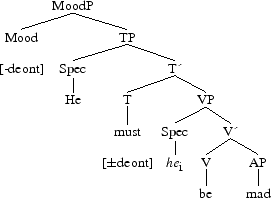
for the epistemic reading of the modal and,
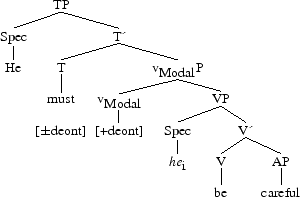
for the deontic reading of the modal.
Let us take some examples we have already mentioned before, that is Examples (617) and (618), which are now numbered (626) and (627).
An ´a speak anything against me, I´ll take him down an ´a were lustier than he is, and twenty such jacks; and if he cannot, I´ll find those that shall. Scurvy knave! I am none of his flirt-gills, I am none of his skain-mates. And thou must stand by, too, and suffer every knave to use me at his pleasure. (R&J II,3 135-40)
Happily met, my lady and my wife./ That may be, sir, when I may be a wife./ That “may be” must be, love, on Thursday next./ What must be shall be. That´s a certain text. (R&J IV,1 18-21)
Let us begin by the epistemic SHOULD and MAY:
if I had, my weapon should quickly have been out.
Happily met, my lady and my wife. That may be, sir, when...
The truth of the relation between the subject and the predicate is underlined in these two examples, and the modal modifies this relation. If an epistemic modal modifies an S(ubject)-P(redicate) relation, it means that it is obligatorily generated higher than the sentence, that is higher than vP (because the S-P relation corresponds to vP, without the satisfaction of the φ and EPP features of T) and higher than TP (which corresponds to the satisfaction of the cited features, except for the tense feature which is satisfied once the modal is inserted). The preceding examples could de illustrated as follows:
SHOULD [my weapon - quickly have been out] (where SHOULD is to modify the relation between the subject “my weapon” and the predicate “quickly have been out”),
MAY [that - be (when)] (where MAY will modify the relation between “that” and “be”).
The truth value of the sentences is questioned: if one had been disrespectful to you, my weapon would have certainly been quick to react (630); if it is true that I can become a wife, then I could be one (631).
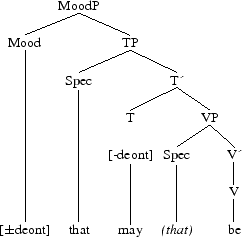
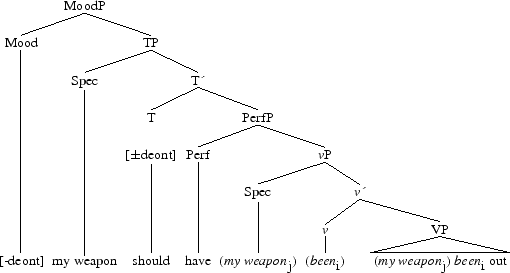
Let us now look at deontic modals:
if he cannot, I´ll find those that shall. [possibility]
and thou must (...) suffer every knave... [obligation]
That “may be” must be, love, on Thursday. [obligation]
What must be shall be. [obligation, necessity]
Deontic modals set a relation between a subject and an activity, concerned with permission, obligation or possibity. It then implies that the S-P relation is not established yet, it is established when the modal in inserted in the morphological component. The deontic reading of the modal is done within the domain of vP: it is the position we have defined in the preceding chapters.
[those - ] SHALL [ - do],
[thou - ] MUST [ - stand by],
[That - ] MUST [ - be],
[what - ] MUST [ - be], [what - ] SHALL [ - be],
where the modal represents the relation between the subject and the predicate.
Then, in Example (636), the subject that “may be” is the semantic subject of be and it becomes the grammatical subject of MUST.The deontic modal establishes a relation between the semantic subject and the predicate when the subject becomes grammatical, that is when MUST is inserted.
The structure of (636) is then,
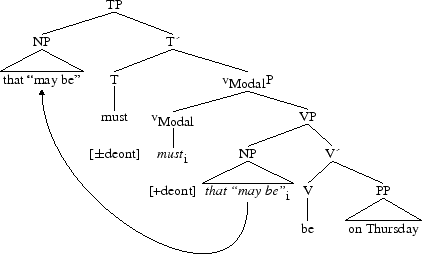
Within VP, the internal argument on Thursday merges with the verb; be then assigns a θ role to its external argument (the semantic subject that “may be”) because the deontic modal must has been chosen in the lexicon. As a consequence, vP merges with TP, and the modal is inserted with its tense and φ features (which are to be satisfied with the φ features of the subject). Once the modal is inserted under T, it satisfies its tense feature; the subject can then raise to Spec,TP to satisfy the EPP features of T.
We have just highlighted that both epistemic and deontic modals have the same syntactic structure: they are both raising verbs. They are both base-generated under T, but the epistemic modal is governed by the functional head Mood within the domain of CP, and the deontic one is governed by the functional head vModal within the domain of vP.
In Section 4.1, we recalled the syntax of epistemic and deontic modals, as well as the syntax of modals when they were used lexically. But unlike OE an ME, we found the contraction of some of these modals, which underlined the fact they had become grammatical items in EME generated under T.
In Section 4.2, we showed that there were less elements in the modal class (compared to OE and ME): some of these verbs did not grammaticalise and were only found as lexical verbs, some have disappeared. From a semantic point of view, we noticed shifts that seemed to go along their grammaticalisation.
In Section 4.3, we first focused on the syntax of the contracted forms of the modals. We then introduced dummy-DO which is generated under T, and which syntactically behaves like modals: we could find the ellipsis of the infinitive verb and it could raise to C in CP-V2 structures. Then, we noticed that the syntactic competition between CP-V2 and SVO structures still existed. Finally, in EME, not became the main negation of the sentence, and we found its contraction on modals and on dummy-DO; and unlike OE and ME, we fould instances of negative polarity items in the corpus: it implies that negative concord disappeared.
In Section 4.4, we stressed that many morphological past forms of modals had an irrealis meaning, particularly in structures where we could find a modal followed by a past infinitive. At the same time, we found more and more forms of modal past which reflected the grammaticalisation (of modal verbs): as the inflections of irrealis forms were no longer visible, past forms, in particular contexts such as clauses introduced by if, came to have an irrealis value (and not a past one anymore).
Finally, in Section 4.5, we analyzed the two modal positions further. Be they epistemic or deontic, modals verbs are raising verbs: the epistemic value is within the CP domain and the deontic value is within the vP domain.